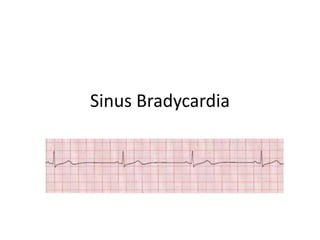
Sinus bradycardia
- 2. Sinus Bradycardia • Sinus rate below 60 beats/minute • Regular rhythm • Occurs normally during sleep – Decreased metabolic demands • Occurs normally in a person with a well- conditioned heart – Athlete • Well-conditioned hearts can maintain a normal stroke volume with less-than-normal effort
- 3. Sinus Bradycardia • How it happens – Normal response to a reduced demand for blood flow • Vagal simulation increases and sympathetic stimulation decreases – Automaticity in the SA node diminishes
- 4. Sinus Bradycardia • A tolerable condition? – Most adults can tolerate a sinus bradycardia of 45- 59 beats/minute – Less tolerant of a rate below 45 beats/minute
- 5. Sinus Bradycardia • Causes – Non-cardiac disorders – Conditions producing excess vagal stimulation or decreased sympathetic stimulation – Cardiac diseases – Certain drugs
- 6. Sinus Bradycardia • No symptoms? No problem • Symptoms? PROBLEM – Prompt attention is critical – Can lead to more serious problems • Hypotension and dizziness • Ventricular tachycardia and ventricular fibrillation
- 7. Symptomatic Bradycardia • If a patient can’t tolerate bradycardia, he may develop these signs and symptoms: – Hypotension – Cool, clammy skin – Altered mental status – Dizziness – Blurred vision – Crackles, dyspnea – Chest pain – Syncope
- 8. Symptomatic Bradycardia • When to call for help and what to do until help arrives – Look at the patient and ask how they are doing – Call for help if heart rate is too slow and/or symptomatic • Compare it their normal heart rate and rhythm – Stay with the patient – If the patient is not breathing and does not respond • Call code • ABCs/CPR
- 9. Sinus Bradycardia • Atrial & ventricular rhythms are regular, as are their rates, except that they’re both under 60 beats/minute
- 10. Sinus Bradycardia • Normal – P wave preceding each QRS complex – PR interval – QRS complex – T wave – QT interval
- 11. Sinus Bradycardia • P wave – rounded, smooth, and upright in lead II, signaling that a sinus impulse has reached the atria
- 12. Sinus Bradycardia • PR interval • Normal indicating that the impulse is following normal conduction pathways – 0.12-0.20 seconds
- 13. Sinus Bradycardia • QRS complex • Normal duration representing normal ventricular impulse conduction and recovery – Less than 0.12 seconds
- 14. Sinus Bradycardia • T wave – Upright in lead II, confirming that normal repolarization has taken place
- 15. Sinus Bradycardia • QT interval – Within normal limits • 0.36 to 0.44 seconds
